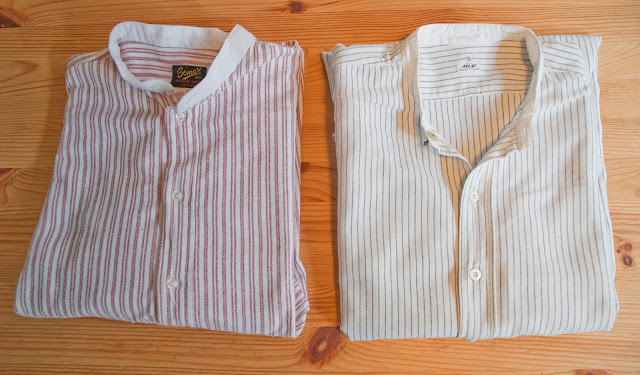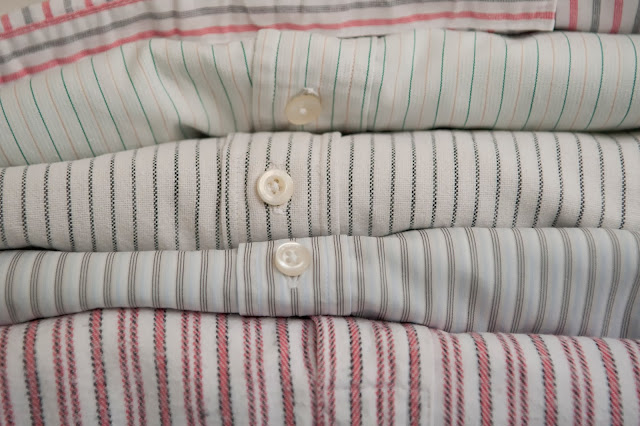The Grand-Daddy of cropped work jackets.
The DNA of the humble battledress blouse can clearly be seen in post-war casual and work jackets sported by the newly demobbed masses - most famously in civilian versions of the American "Ike" jacket.
Looking for a replacement for WW1 era Service Dress (SD) that was both more suited to vehicle mounted operations, and allowed our chaps better ease of movement, The War Department, after several trials, settled on Battledress, Serge in 1937.
Issued on a large scale in 1939, this is the uniform that most British and Dominion troops set off to war with.
Made from heavy wool serge, with mixed green and brown fibres, these are robust little jackets. Much shorter than its SD tunic predecessor, the BD blouse was originally worn over a collarless shirt and buttoned at the back to a heavy pair of matching trousers.
With an extremely high waist line that hovered dangerously close to the nipples, this was clearly meant to give a silhouette that emphasised height - important when attempting to instil fear in the the hearts of advancing German infantry!*
 |
| War Department size label. |
 |
| 1949 Pattern blouse. Notched collar, for wear with a shirt & tie. |
Various patterns were made over the years. The 1937 version had a rise & fall collar, buttoned to the top, (though officers often had theirs tailored to wear with a collar & tie.)
The blouse you see here is the 1949 version, made in 1952 by Prices Tailors Ltd. (There were a myriad number of contractors over the years. Sadly I could not find any information on Prices.)
 |
| The 1949 blouse could still be buttoned up against the elements. This reflects its dual use as combat and formal uniform after WW2. |
Sporting an open notched collar this blouse was meant to be worn with a shirt & tie.
This type of battledress was often used as an alternative "walking out" uniform to Service Dress. As a combat uniform it was still worn in Korea, but fell in to disuse with the issue of Herringbone Twill uniforms poached from the Americans.
As our own cotton combat uniform came in to service there was no real need for two types of formal uniform and battledress ceased to be issued in 1961.
As our own cotton combat uniform came in to service there was no real need for two types of formal uniform and battledress ceased to be issued in 1961.
 |
| Smart fly front over the buttons. Acres of velcro and zips have replaced buttons on today's uniforms, but the fly front served the same purpose - preventing buttons catching on bits of kit. |
I will say that wool serge, though heavy, creases easily. Unusually for Army uniform the blouse seems stubbornly resistant to all attempts to iron these creases out of it. Quite how this went down with generations of Sergeant Majors I'll never know.
 |
| Belted up, these blouses look rather snappy. If you prefer that louche, some would suggest scruffy officer look, leave it undone! |
With pleats front and rear these blouses are quite roomy so, worn with some heavy jeans or flannels, they look great over a guernsey or a submariner. Just the thing for cutting about town in late autumn. Or a clandestine meeting with your resistance contact to blow up a bridge!
Interestingly The War Department also issued a denim working dress version of this uniform. As the name would suggest it was meant for menial work, however it was widely issued to front line Tommies on the Mediterranean Campaign. Plans are afoot to track down a denim blouse as soon a possible.
Interestingly The War Department also issued a denim working dress version of this uniform. As the name would suggest it was meant for menial work, however it was widely issued to front line Tommies on the Mediterranean Campaign. Plans are afoot to track down a denim blouse as soon a possible.
Earlier examples are becoming scarce, but post war versions are still straightforward to find. You can also still easily get hold of the later Greek & Dutch Army blouses. I found mine on Fleabay, but it is worth checking surplus suppliers to see what they have. There are also various reproduction companies making copies for re-enactor types, but I cannot vouch for these. I'd argue you're better off with an original.
*Apparently such large stocks of battledress blouses were left behind at Dunkirk that they were recycled by the Germans and issued to U Boat crews. Later in the war, with Germany unable to produce enough wool for their longer uniform tunics, in 1944 they introduced their own version made from shoddy (recycled wool.)
















































